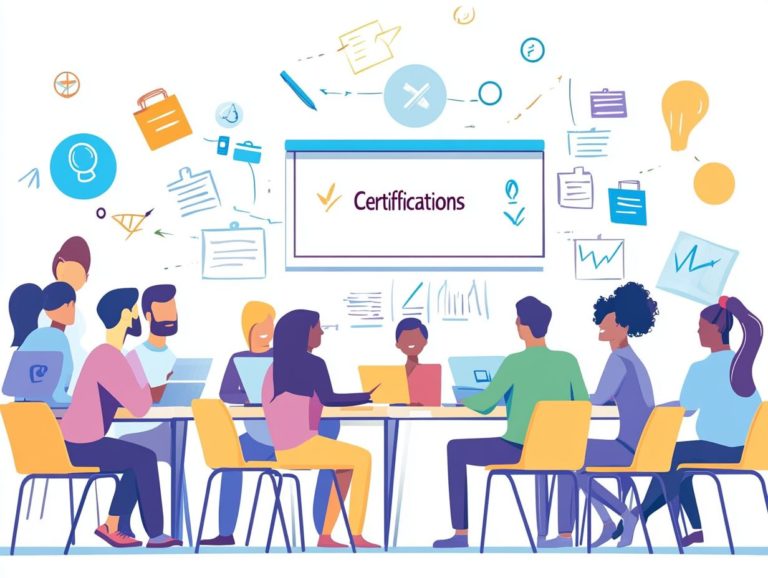How to Validate an Educational Certification Program
The job market is competitive. Securing the right educational certification can significantly impact your career.
With countless programs available, how can you choose one that is credible and valuable?
This article explores how to validate educational certification programs and why it matters.
You’ll learn crucial steps for assessing programs, pitfalls to avoid, and helpful resources.
Make informed decisions to empower your professional development and elevate your career!
Contents
- Key Takeaways:
- Importance of Validating Educational Certification Programs
- Steps to Validate an Educational Certification Program
- Common Pitfalls to Look Out For
- Resources for Validating Educational Certification Programs
- Frequently Asked Questions
- What is an educational certification program?
- Why is it important to validate an educational certification program?
- How can I validate an educational certification program?
- What is the role of accreditation in validating an educational certification program?
- Can I trust an educational certification program that is not accredited?
- Are there any red flags to look out for when validating an educational certification program?
Key Takeaways:

Validate educational certification programs. This ensures they are credible and valuable for both students and employers.
Research the program, check its accreditation, review the curriculum, assess instructors, and evaluate student outcomes.
Be aware of red flags and use reliable tools to avoid common mistakes when validating programs.
What are Educational Certification Programs?
Educational certification programs equip you with the necessary qualifications and skills to become a certified educator.
These programs can be found in states like Texas and meet the certification requirements set by bodies like the Texas Education Agency (TEA).
They are essential for anyone pursuing educator certification, whether through traditional routes or online training.
With different formats available, from in-person courses to flexible online classes, you can choose what fits your lifestyle best.
These programs prepare you for diverse educator roles, especially within the military community, where unique educational challenges arise.
Completing these programs fulfills licensure obligations and enhances your qualifications for positions, even if you plan to transfer your teaching credentials out of state.
Educational certification programs shape skilled educators ready to meet diverse student needs.
Importance of Validating Educational Certification Programs
Validating these programs ensures they meet established standards and adequately prepare educators.
This involves checking certification and reviewing records to confirm compliance with the Texas Education Code.
By validating programs, we foster trust and accountability in the education system, benefiting both educators and students.
Benefits of Validating Programs
Validating educational certification programs leads to better certification rates and quality instructors.
Regular feedback evaluations help identify strengths and areas for improvement, ensuring educators meet student needs.
Valid programs create more certification opportunities, boosting prospects for professional growth.
This validation builds trust not just among educators, but within the community, expanding job opportunities in academia.
You gain a competitive edge, knowing you’re part of a recognized system focused on quality instruction.
This trust can significantly benefit the military community, where educational aides can enhance their skills through validated programs.
As military personnel earn more qualifications, they can smoothly transition into civilian teaching roles, enriching education and encouraging lifelong learning.
Steps to Validate an Educational Certification Program
Validating an educational certification program requires a systematic approach with key steps that ensure alignment with regulatory requirements and understanding the requirements for educational certifications.
Start by gathering and reviewing certification records to assess past performance and outcomes.
Next, evaluate the program’s goals to ensure they meet industry standards. Consider factors like accreditation and the effectiveness of online training modules.
This careful approach guarantees compliance and boosts the quality of your education!
1. Research the Program

The first step in validating a program is thorough research. Examine its stated goals to see how well they align with certification processes.
Gather information from various sources like official documentation and reports from educator preparation programs. This will give you valuable insights into the curriculum and the program’s mission.
Testimonials from past students can provide personal experiences and highlight outcomes achieved through the program.
By evaluating these goals within the context of educator preparation, you can assess their relevance in today s educational landscape. It s crucial to ensure that aspiring educators gain essential skills for modern classrooms.
2. Check Accreditation
Checking for proper accreditation is vital for validating educational certification programs. Accreditation ensures these programs meet established standards and comply with the Texas Education Code (the set of laws governing education in Texas).
Confirm that the program is part of an approved Texas Educator Preparation framework to establish its credibility. Accreditation is a critical indicator of the quality of educational offerings.
Verifying accreditation involves examining adherence to guidelines set by recognized accrediting bodies. This evaluation looks at criteria like curriculum strength, faculty qualifications, and student outcomes.
A recognized accreditation can significantly boost a program’s value in the eyes of employers, influencing hiring decisions and expanding career opportunities for graduates.
3. Review Curriculum and Course Materials
Reviewing the curriculum and materials is essential in validating certification programs. This process reveals alignment with certification requirements and industry standards.
Analyze how well course offerings match the skills expected of certified educators and the program s educational goals. It s important to assess the relevance of learning outcomes to real-world scenarios.
This ensures aspiring educators are prepared for challenges in diverse classrooms. Compare the curriculum against established frameworks like the National Board for Professional Teaching Standards.
By focusing on systematic reviews, you can enhance your programs and produce candidates ready to contribute effectively to student success in an evolving educational landscape.
4. Assess Quality of Instructors
Assessing the quality of instructors in your educational certification program is essential for effective training. You can achieve this by gathering opinions from students. This feedback provides invaluable insights into instructor performance and their ability to engage and educate effectively.
In addition to gathering feedback from students, implement classroom observations to evaluate instructional practices. These observations capture the dynamics of teaching and learning in real-time, revealing strengths and areas for improvement for each instructor.
Use various tools like anonymous surveys and peer reviews to enhance observations. This comprehensive approach not only enriches the training provided to educators but also influences student outcomes, fostering a more effective learning environment that supports your academic success.
5. Evaluate Student Outcomes
Evaluating student outcomes is an essential final step in validating educational certification programs. It reveals how effectively your program prepares candidates for real-world teaching scenarios.
By analyzing certification rates and the overall success of graduates, you provide stakeholders with valuable insights into the program’s effectiveness and identify areas for enhancement.
To assess these outcomes effectively, consider implementing various methods. Collect data on job placements, monitor alumni achievements, and conduct surveys to gather feedback on graduates’ experiences in their new roles.
These approaches reveal both employment rates and graduates’ confidence in their teaching roles. Tracking longitudinal data helps establish trends over time, offering a comprehensive understanding of your program’s impact.
Engaging with employers for feedback can further enrich the evaluation process, ensuring that your curricula align with the evolving needs of the educational landscape.
Common Pitfalls to Look Out For

When validating educational certification programs, be mindful of common pitfalls that could undermine the process. These pitfalls may include:
- Overlooking essential records,
- Inadequately assessing the program’s alignment with educator preparation initiatives,
- Failing to stay current with standards established by regulatory bodies.
By recognizing these issues, you can maintain the program’s credibility and effectiveness in cultivating qualified educators.
Red Flags in Program Validation
Recognizing red flags during program validation is essential for ensuring the credibility and quality of educational certification programs. These indicators can unveil underlying issues that threaten the program’s integrity.
For instance, a lack of proper accreditation, insufficient certification verification processes, and negative feedback from past participants suggest that a program may not meet necessary standards.
Additionally, be cautious of an overly simplistic curriculum that skips essential topics. If a program claims to offer comprehensive training but glosses over significant areas, it s time to dig a little deeper.
Watch out for high-pressure sales tactics from admission representatives; these can signal a greater emphasis on profit rather than the quality of education. It’s also crucial to be wary of programs that don t provide clear information about their instructors qualifications; inexperience can detrimentally impact the learning experience.
By keeping an eye out for these red flags, you enable yourself to make informed decisions about your educational pursuits.
Resources for Validating Educational Certification Programs
You have access to a wealth of resources designed to help validate educational certification programs. These resources ensure you receive the guidance and support you need throughout this process.
Explore documentation from the Texas Education Agency (TEA), online platforms specifically for certification verification, and accreditation bodies that supply vital information on approved educator preparation programs.
Don’t miss out! Take action now to ensure your educational journey is successful.
Useful Tools and Organizations
A range of valuable tools and organizations is at your disposal to help validate educational certification programs. This ensures they meet compliance and effectiveness standards. You can explore online certification lookup tools, regional educational service centers, and accreditation bodies dedicated to maintaining educational quality.
For example, platforms like the National Association of State Boards of Nursing (NCSBN) offer a database for verifying nursing licenses. This provides reassurance to both employers and job seekers.
Regional educational service centers serve as essential resources, guiding you through the complexities of program accreditation.
Organizations such as the Council for Higher Education Accreditation (CHEA) play a vital role by evaluating and endorsing accredited institutions. They assist educators and employers in identifying reputable programs while upholding high educational standards.
Harness these tools to boost your credibility and make informed choices! Your educational journey matters!
Frequently Asked Questions
What is an educational certification program?

An educational certification program is a training or learning program designed to provide individuals with the knowledge, skills, and competencies necessary to pursue a specific career or profession.
Why is it important to validate an educational certification program?
Validating an educational certification program ensures that the program meets certain standards and is recognized by relevant authorities or regulatory bodies. For more information on this process, consider navigating the world of educational certifications, which adds credibility to the program and the certification you earn from it.
How can I validate an educational certification program?
The first step to validating an educational certification program is to research the program and the institution offering it. Look for accreditation of educational certification programs from recognized organizations and check if the program meets industry standards and requirements.
What is the role of accreditation in validating an educational certification program?
Accreditation means a program is reviewed by experts to ensure it meets quality standards. This process adds credibility and legitimacy to an educational certification program.
Can I trust an educational certification program that is not accredited?
While accreditation is not a requirement for an educational certification program, it is highly recommended to choose a program that is accredited by a recognized organization. This will ensure that the program meets certain standards and is recognized by potential employers or other institutions.
Are there any red flags to look out for when validating an educational certification program?
Watch out for these red flags:
- Lack of accreditation
- High fees
- Promises of guaranteed job placement
It is important to thoroughly research and evaluate a program before enrolling in it.






